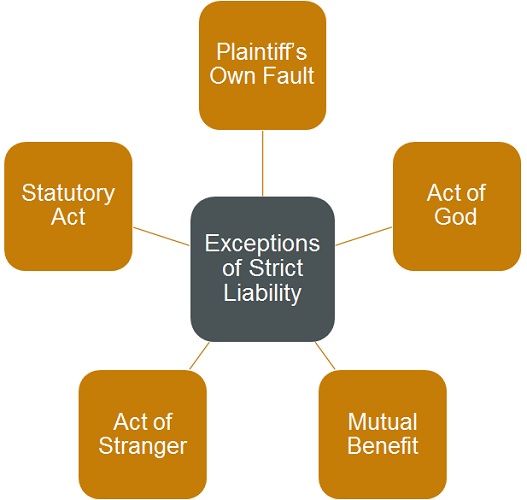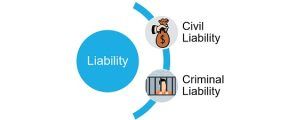 While both strict and absolute liability arises from keeping or bringing hazardous products or carrying out dangerous activities which may harm another person, even when precautions are taken. In both cases, there is no need to prove the negligence of the defendant.
While both strict and absolute liability arises from keeping or bringing hazardous products or carrying out dangerous activities which may harm another person, even when precautions are taken. In both cases, there is no need to prove the negligence of the defendant.
The difference between strict liability and absolute liability is based on the fact whether the defence of a mistake of fact is there. In the case of absolute liability, a mistake of fact is not considered a defence. Basically, absolute liability is way more stringent than strict liability.
What is No-Fault Liability?
If due to the mistake of the defendant the legal right of the plaintiff is violated. So the defendant is liable to pay compensation, this is a fault-based liability. But when there is a violation of the plaintiff’s right, but the violation is not done by the defendant, even then the defendant is liable to pay compensation to the plaintiff it is a no-fault liability.
In short, liability arising without any fault is a no-fault liability. It covers two kinds of liability:
- Strict Liability
- Absolute Liability
Content: Strict Liability Vs Absolute Liability
Comparison Chart
| Basis for Comparison | Strict Liability | Absolute Liability |
|---|---|---|
| Meaning | Strict Liability implies the legal responsibility of a person for compensating the injured or aggrieved, even when he or she was not at fault or negligent. | Absolute Liability arises from inherently hazardous activities like keeping dangerous animals or using explosives. |
| Talks about | Person | Enterprise |
| Escape | Necessary | Not Necessary |
| Exceptions | Yes | No |
| Payment of compensation | Nature and quantum of damages | Exemplary in nature |
What is Strict Liability?
The rule of strict liability evolved in the year 1868, in the case of Rylands Vs. Fletcher.
According to this principle, if someone (defendant) keeps or brings hazardous substances on his premises, then he will be held responsible if the substances escape the premises and it harms another person (plaintiff). Although there is no negligence on the part of the defendant, he has no intention to harm another person. This means that the prima facie liability is of that person who keeps the hazardous substances.
In these situations, even the defence of an unavoidable accident is not a genuine defence. This is called the principle of strict liability.
Further, in the case of strict liability, the burden of proof is always on the defendant. This means that the defendant has to prove why he is not liable to pay the damages. Also, there is no need to prove fault, negligence or intention. The claimant is required to prove that tort took place and the defendant is responsible for the same.
Principles of Strict Liability
It is based on three basic principles:
- Non-Natural use of land: Considering the case of Ryland v. Fletcher, the collection of water for domestic use is a natural use but in that case, water is stored for commercial use, i.e. for energizing a mill, which is a non-natural use. Here, by the term land, we mean natural resources or inputs.
- Dangerous Substance: Any substance that causes some mischief or harms others when it escapes from the premises is a dangerous substance. This may include any kind of explosives, toxic gases, electricity and so on.
- Escape: It should escape from the premises of the defendant and should be away from his/her reach.
Exceptions
- Plaintiff’s Own Fault: When the cause of the damage is an act or default of the claimant himself, no remedy would be available to the plaintiff in that case. Example Ponting Vs. Noakes
- Act of God: When the escape is caused directly by the natural causes without any human intervention. Then the defendant can use the act of God as a defence. Example: Nichols Vs Marsland.
- Mutual Benefit: When there is express or implied consent of the plaintiff to the presence of the source of damage or danger. Also, there is no negligence on the part of the defendant. In such a case the defendant will not be held liable.
- Act of Stranger: When the cause of harm is the act of a stranger or third party. Here, it should be noted that this third party is neither the servant of the defendant nor he is having any control over that person.
- Statutory Act: If it is an act of the government or corporation, then it is also a defence.
What is Absolute Liability?
When a profit-making enterprise is indulged in carrying out any inherently dangerous activity, and if any damage is caused to any party, due to the conduction of that activity. In such a case, the defendants, i.e. the company owners will not take recourse of any defence or exception and they will be completely responsible for that damage.
So, they have to pay compensation to the aggrieved party. Further, the undertaking will be liable for all possible damages or consequences arising out of that activities.
The essence of this law is to make such industries supply all the necessary safety equipment and follow all the safety measures to prevent the workers from any mishap. So, this is to protect the interest of the workers and also to provide them with a safe working environment.
According to this concept, if any enterprise (for-profit organization) is involved in any hazardous activity and it causes any harm to the people, then it is the liability of the organization to pay the damages, irrespective of the fact that the escape happened or not.
This means that it is not necessary that the damages will be paid only when the hazardous component goes outside the campus of the enterprise, rather if it causes damage to the people working inside the campus then also the damages will be paid by the enterprise involved in the activity.
History
Supreme Court created the doctrine of absolute liability, in preference to the doctrine of strict liability. This decision was made by the court after two major gas leaks:
- Escape of Methyl Isocyanate from Union Carbide Plant – Bhopal Gas Tragedy
- Leakage of Oleum Gas from one of the units of Sriram Food and Fertilizers Industries
Because the first incident caused great damage to thousands of people. The Supreme Court of India was in fear that the industries that deal with hazardous substances would be free from the liability for damages that took place due to the leakage of deadly gases, because of the exceptions under strict liability. This gave birth to the doctrine of absolute liability.
Principles of Absolute Liability
So, it is also based on three principles which are:
- Enterprise
- Hazardous Activity
- Escape not necessary
There are no exceptions in the case of absolute liability. The quantum of damage is always proportional to the size of the enterprise.
Justification by court
The enterprise undertaking the hazardous and inherently dangerous activity for private profit is socially obligated to pay for the damages suffered by any person therefrom. Further, it should be absorbed as a part of overheads.
The enterprise has the resources to identify and protect against such hazards and perils.
Key Differences Between Strict Liability and Absolute Liability
The pointers given below will provide you with the difference between strict liability and absolute liability:
- Strict Liability arises in cases in which the court holds one party responsible for losses, even if such losses are neither intentionally nor negligently suffered by another person. However, when there is an injury to a worker while performing some activity during employment, the court holds the employer responsible for providing benefits, which are specified in labour law. Here it is immaterial who caused the injury, i.e. be it caused by the worker, co-worker or due to any act of the employer. In most cases, the employer pays the liability. This is what we call absolute liability.
- Offences of strict liability will get a number of defences. Whereas absolute liability creates a high degree of criminal duty, the person committing the act will be guilty in a maximum number of cases.
- While strict liability is applicable to persons, absolute liability is applicable to enterprises, i.e. commercial undertakings.
- In the case of strict liability, the escape of hazardous or dangerous components from the perimeter of the owner is necessary. But escape is not necessary in the case of absolute liability.
- In the case of strict liability, the defendant has got certain exceptions that he/she can use to prevent himself from the liability. But, no exceptions are provided in the case of absolute liability to the defendant. This means that, if any person faces damages due to the hazardous element, then the defendant would be absolutely liable for the same.
-
What about Compensation?
Payment of compensation in the case of strict liability is as per the nature and quantum of damages incurred. However, in the case of absolute liability, compensation paid is a deterrent in nature. That is why the amount decided has to be more than the damage suffered because industrial accidents usually result in mass death and destruction of property and the environment. This implies that the quantum of damages relies on the magnitude and financial capability of the organization.
Conclusion
So friends, what we have learnt is the rule of absolute liability resembles strict liability but with some important modifications. Due to this rule, an individual becomes completely liable for any damage without any defence.







SATHYA says
Good
Sanjeev Kumar says
Well drafted . Thanks
Alex says
I really liked this article thanks for your initiative. long live the developer and designer of this website